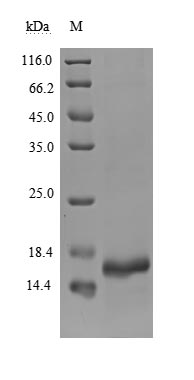Recombinant Human Novel Coronavirus Non-structural protein 8 (ns8) is expressed in E. coli, covering the full length of the mature protein from amino acids 16 to 121. This protein is N-terminally 6xHis-tagged and achieves a purity level greater than 90% as confirmed by SDS-PAGE. The product is designed for research use only and is not intended for diagnostic or therapeutic applications.
Non-structural protein 8 (ns8) of the SARS-CoV-2 virus appears to play a crucial role in viral replication and transcription processes. It forms part of the replication-transcription complex that seems essential for viral RNA synthesis. Understanding ns8's function and structure may prove important for coronavirus biology research and the development of potential antiviral strategies.
Potential Applications
Note: The applications listed below are based on what we know about this protein's biological functions, published research, and experience from experts in the field. However, we haven't fully tested all of these applications ourselves yet. We'd recommend running some preliminary tests first to make sure they work for your specific research goals.
SARS-CoV-2 ORF8 is a viral accessory protein that requires precise folding, disulfide bond formation, and proper dimerization for its functional activity in immune evasion (e.g., MHC-I downregulation). The E. coli expression system cannot provide the necessary environment for correct disulfide bond formation and oligomerization. The protein fragment (16-121aa) may lack critical structural elements, and the N-terminal 6xHis tag may interfere with native folding. While the protein may be soluble, it is highly unlikely to achieve the correct disulfide-bonded dimeric structure required for biological activity.
1. Antibody Development and Characterization
This application is highly suitable as antibody development relies on antigenic sequence recognition, not native folding. The protein can generate antibodies against linear epitopes of ORF8. However, antibodies may not recognize conformational epitopes dependent on disulfide bonds or dimerization.
2. Biochemical and Biophysical Characterization
These studies can assess physical properties (e.g., size, aggregation) but cannot confirm native structure. Techniques like SEC may detect oligomerization, but cannot distinguish native dimers from aggregates.
3. ELISA-Based Binding Assays
ELISA depends on epitope recognition, not functional conformation. This application is suitable for detecting antibodies or other binders to linear epitopes. However, it cannot model native protein interactions due to likely misfolding.
Final Recommendation & Action Plan
The E. coli-expressed ORF8 fragment is unsuitable for functional studies due to probable misfolding and lack of disulfide bonds. It can be used for antibody production (Application 1) and basic biophysical characterization (Application 2), but avoid interaction studies and functional binding assays. For authentic ORF8 research, use a mammalian-expressed protein with proper disulfide bonding. Begin with biophysical characterization to assess aggregation state. Proceed with antibody development for linear epitopes. All functional applications require alternative protein sources with verified disulfide bonding and dimerization.






